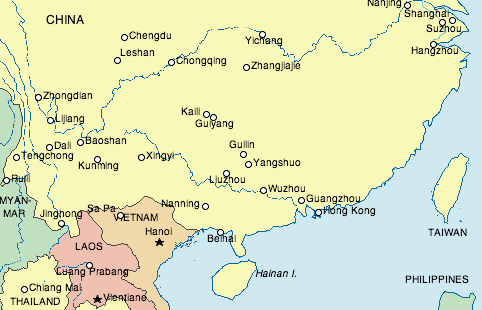Yichang & Yangtse Dam

As we were checking into our hotel, Joe Peng, 30-something young entrepreneur that was with us on our trip up the little gorges showed up with four of his travelling friends: “Most young people like me are in business. I am in charge of sales for a Christmas tree company and I also own my own business. Our sales keep going up…we can’t figure out how so many people could want so many fiber optic trees!” Nine foot trees go to distributors for $80 who then sell them to hotels and other businesses all over the world for $900. His boss for 8 years was Canadian and now his English is great so we jumped at the chance to go with Joe and his friends in a van back to the construction site.
The Construction Site
In 1995, when Winchester wrote his book, the journey from Yichang to the construction site took four hours. The road vanished after five miles and was replaced by a track clogged with every kind of construction vehicle, van, bus, taxi, tractor, crane, backhoe, bulldozer, motorcycle and ricksha imaginable, he says. The giant expressway that carried our bus for the 40 minute journey to the site was just being built halfway up the mountainside. Winchester was able to walk unescorted among the giant bulldozers and excavators, to talk to workers who slept in tents near their work sites. Some 20,000 workers toiled on the site and by the end of 1996 there was 35,000 many of whom were soldiers…some said to be prisoners, laboring on the project at no cost.
When we decided to visit the site this is what I had pictured. But all that is available to the traveller now is a viewing site on Zhongbao Island between the dam and the locks…China requiring each Yichang city Number 8 bus load, or “tour group,” to be accompanied by a “tour leader” that does nothing except ride along. The concrete has been poured and the locks are nearly finished and will be in operation by June of this year although the entire reservoir behind the dam won’t be completely filled until 2009.
The Controversy
The dam has it’s detractors…Dai Qing, a journalist trained as an engineer, earned herself a 10 month spell in prison for her outspoken book “Chang Jiang, Chang Jiang” that was published just a few months before the student uprising that culminated in the Tiananmen Square tragedy in Beijing. Dai was appalled at the risky business of building the dam and throughout the late eighties she carefully collected a series of academic papers by well-respected engineers and hydrologists, each of whom had competent, well-argued and sound reasons for opposing the dam.
Within months, according to Simon Winchester in his “The River At The Centre Of The World,” all of China’s elite and intelligentsia knew of the risks of the monster project. In 1992 nearly 180 men and women from what was called the Democratic Youth Party in Kaixian country were reportedly taken away by police and charged with sabotage and counter-revolutionary activity relating to their opposition to the dam. According to Winchester they have not been heard of since.
Friends of the Earth has said the dam will create a 480km long septic tank backing up clear to Chongquin. The rising water will cover countless cultural artefacts at over 8000 archaeological sites, many of which have not yet been properly studied. But almost all the criticism of the dam is based on on the assumption that it will not last for a franction of the anticipated time, that its effects will be minimally beneficial and possibly an environmental disaster and that it may turn out to be a catastrophe waiting to happen.
Dams break, and it is now known that at least two have broken with disastrous results because of either substandard construction or poor design. For example, The Banqiao, an earthen dam on a tributary of the Lower Yangtse in Henan province was long regarded as an iron dam-one that can never fail. But a rainstorm associated with a typhoon in August 1975 forced the reservoir behind the dam to rise nearly seven feet overnight and the heavy siltation at the base of the structure prevented the water from flowing away even when the sluice gates were wide open. The water finally overtopped the dam and the vast structure burst resulting in a lake that stretched for thirty miles downstream and whole villages were inundated in seconds. Various human rights groups have suggested that almost a quarter of a million people died. The Chinese said nothing about the catastrophe and news finally seeped out of the country only in 1994, nearly 20 years after the event…something not possible if the Yangtse dam were to go.
Tags: China, Excursions, Reading, Yangtse River, Yichang


Leave a Reply